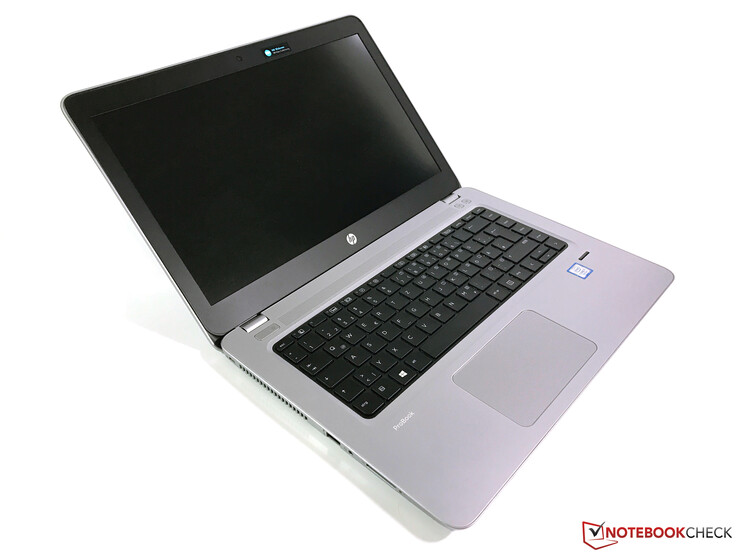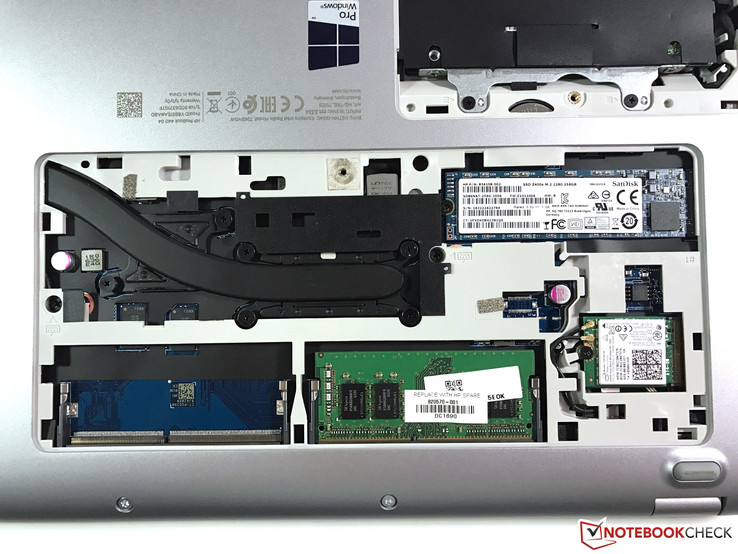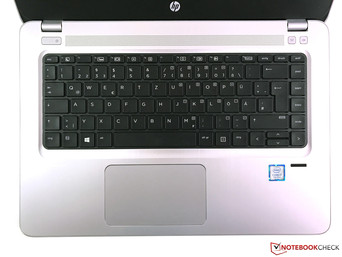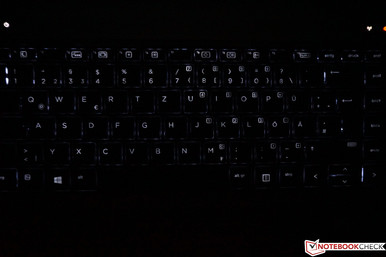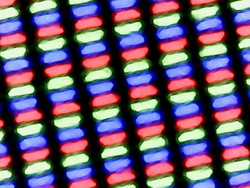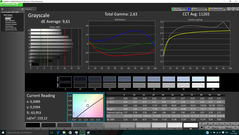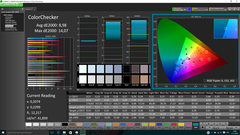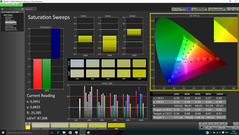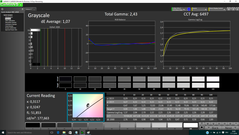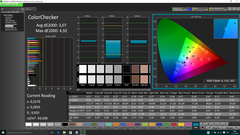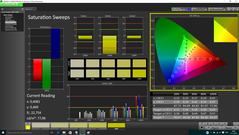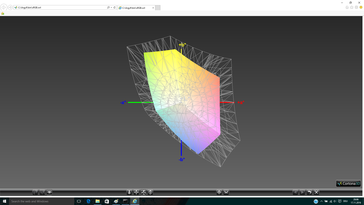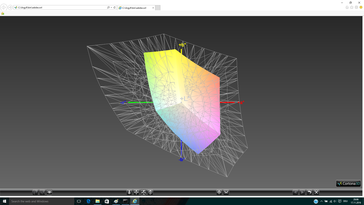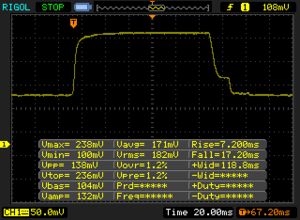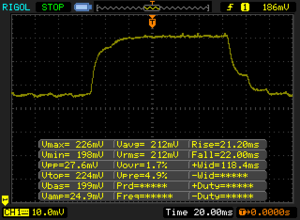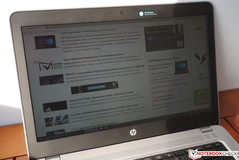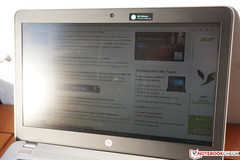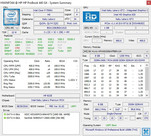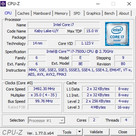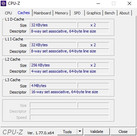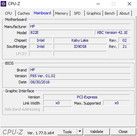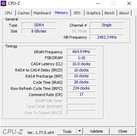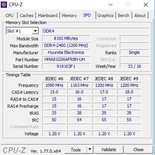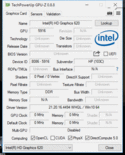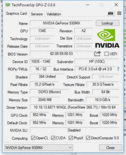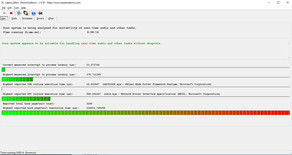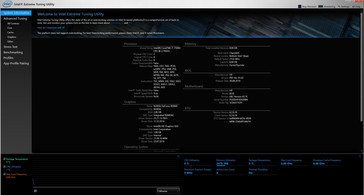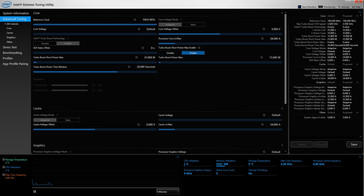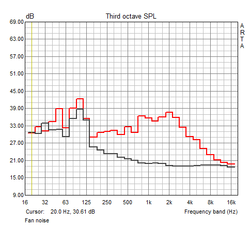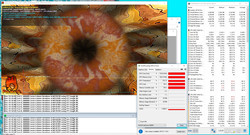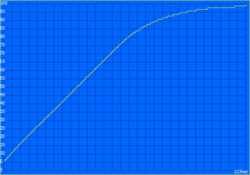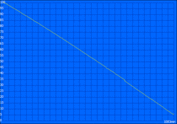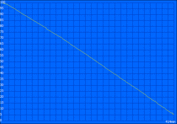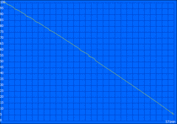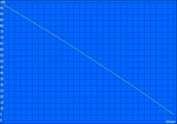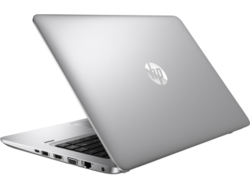HP ProBook 440 G4 (Core i7, Full-HD) Notebook Review

For the original German review, see here.
We have already reviewed the 13, 15 and 17-inch models of the HP ProBook 400 lineup, so only the 14-inch laptop remains. This laptop series represents entry-level business solutions, followed by the ProBook 600-series as well as the EliteBook 800-series, where updates have just been announced. The three models we have tested so far have left a positive impression for the most part.
Our test model today carries the designation ProBook 440 G4-Y8B51EA and is one of the most expensive SKUs at 1050 Euros (~$1127). It is equipped with a fast Core i7 processor, 8 GB DDR4 RAM, a dual-storage solution (SSD+HDD) as well as a dedicated GeForce graphics card from Nvidia. The most obvious drawback is the display, which features the Full HD resolution, but is only based on the TN technology.
Unlike the consumer devices, 14-inch systems are pretty popular amongst professional laptops. There are numerous rivals, but so far, only the Lenovo ThinkPad E470 has been updated with new Kaby Lake CPUs. We are still waiting for the new models from other manufacturers, so we will also use the Dell Latitude 14 E5470 and the Acer TravelMate X3 X349-M-7261 for the comparison.
Case
The case of the ProBook 440 G4 basically only differs from its siblings in terms of the size. HP uses a silver plastic chassis, which has been reinforced with aluminum on the top of the base unit. There are still black elements such as the keyboard or the display frame, but the lid is now silver as well, while the predecessor had a black lid.
The stability is very decent and only slightly worse compared to the more compact 430 G4. Pressure is not a big problem for the base and we can only notice minimal bouncing in the center of the keyboard area when you type with a lot of force. We only noticed quiet creaking sounds when we used the laptop in practice. The weak spot is still the thin display cover, where pressure will quickly result in ripples on the screen. We liked the hinge much better. The fourth generation now uses a drop-down mechanism, which is well-adjusted and can be opened with just one hand, but the maximum opening angle is not that generous at around 130 degrees. At the bottom are two maintenance hatches secured by a Philips screw and some plastic clips. The battery cannot be removed easily.
Both the build quality and the stability of the case are very decent in general. However, more expensive business notebooks as well as premium consumer notebooks with unibody constructions are even better in this respect.
All four devices are quite similar in our size comparison, only the Acer TravelMate X3 is noticeably slimmer and lighter. However, the ProBook 440 G4 is still slightly lighter than the other two rivals at 1.7 kg (~3.75 lb) and the laptop is a good compromise between size and mobility.
Connectivity
The port equipment does not differ from the smaller ProBook 430 G4 and HP has changed only one port compared to the predecessor ProBook 440 G3: One standard USB 3.0 port (Type-A) has been replaced by a Type-C jack (USB 3.1 Gen.1). However, the latter supports only the USB protocol, but not any additional features such as USB power delivery or Thunderbolt 3. TB3 in particular would have been a very comfortable and future-proof solution, especially considering the missing docking port. This makes it harder to integrate the device in work environments, because you will still have to attach at least the power adapter as well as port replicators. The USB ports are also at the center of the sides, which is not a perfect solution for permanently attached peripherals.
Otherwise, the ports are rather outdated, because a USB 2.0 port and a VGA output are no longer common. High-resolution 4K screens can only be driven at 30 Hz via HDMI. At least the performance of the USB ports does not cause any criticism. We determined transfer rates of up to 380 MB/s in combination with our external Samsung SSD T3.
SD Card Reader
The SD card reader is located at the left front and manages average transfer rates in our tests. We can determine up to 90 MB/s in combination with our reference card from Toshiba (Exceria Pro SDXC 64 GB UHS-II, up to 260 MB/s). The card could reach higher results, but the ProBook 440 G4 is still on the usual level. Only the rival from Dell performs much better.
| SD Card Reader | |
| average JPG Copy Test (av. of 3 runs) | |
| Dell Latitude 14 E5470 | |
| HP ProBook 430 G4-Y8B47EA | |
| HP ProBook 440 G4-Y8B51EA | |
| HP ProBook 450 G4 Y8B60EA | |
| Lenovo ThinkPad E470-20H2S00400 | |
| Acer TravelMate X3 X349-M-7261 | |
| maximum AS SSD Seq Read Test (1GB) | |
| Dell Latitude 14 E5470 | |
| HP ProBook 450 G4 Y8B60EA | |
| HP ProBook 430 G4-Y8B47EA | |
| HP ProBook 440 G4-Y8B51EA | |
| Lenovo ThinkPad E470-20H2S00400 | |
| Acer TravelMate X3 X349-M-7261 | |
Communication
The wireless module provided by Intel has the designation Dual-Band Wireless-AC 7265. This module has been available for a while and has already got a successor (Wireless-AC 8265), but it supports the fast 802.11ac standard (2.4 & 5 GHz) and reaches a maximum transfer rate of 866 Mbps. The test model performs better than the recently reviewed ProBook 430 G4 in our standardized WLAN test with the router Linksys EA8500. Around 540 Mbps receive and 450 Mbps send are decent results and we did not experience any issues during our review period. Connections with other devices can also be established via Bluetooth 4.2. There is also a Gigabit Ethernet port for wired networks and HP offers an optional LTE module (HP lt4132 LTE 4G).
A 720p webcam as well as two microphones are located above the display. The webcam does its job, but you should not expect too much. The microphones on the other hand, work very well.
| Networking | |
| iperf Server (receive) TCP 1 m | |
| Lenovo ThinkPad E470-20H2S00400 | |
| HP ProBook 450 G4 Y8B60EA | |
| Acer TravelMate X3 X349-M-7261 (jseb) | |
| HP ProBook 440 G4-Y8B51EA | |
| HP ProBook 430 G4-Y8B47EA | |
| iperf Client (transmit) TCP 1 m | |
| Acer TravelMate X3 X349-M-7261 (jseb) | |
| HP ProBook 450 G4 Y8B60EA | |
| HP ProBook 440 G4-Y8B51EA | |
| Lenovo ThinkPad E470-20H2S00400 | |
| HP ProBook 430 G4-Y8B47EA | |
Security
Business devices obviously have a bigger focus on the security. The ProBook 440 G4 is equipped with a Trusted Platform Module 2.0, a vibration sensor for the hard drive, a slot for a security lock, and a fingerprint scanner. The finger has to be swiped across the scanner. This works well as long as you do not swipe your finger too quickly, but modern touch sensors are more comfortable.
As far as software is concerned, HP has installed its Security Manager, which combines all security settings in one simple interface. You can, for instance, set up passwords or register fingerprints. The only thing we miss is a SmartCard reader, which is not available as an option either.
More settings are available in the comprehensive BIOS, which can be controlled via the touchpad. We have added some screenshots below for an overview.
Accessories
HP ships the ProBook 440 G4 with only a 65-watt power adapter (45 watts for the model without dedicated GPU) and some service leaflets. The manufacturer offers some generic accessories such as USB docking stations, bags or power adapters.
Maintenance
The HP ProBook 440 G4 has two maintenance hatches at the bottom. They are secured by one Philips screw and additional plastic clips, so you should be careful when you remove them. You get access to the 2.5-inch hard drive, the M.2-SSD (2280), the WLAN module as well as the two RAM slots. We are still not entirely satisfied. You cannot access the battery, the CMOS battery, the fan, or the optional LTE module without further disassembly of the bottom panel (secured by small Torx screws).
Warranty
That we are dealing with an entry-level business device is also reflected by the warranty. Unlike the more expensive premium products, where the warranty period is usually 36 months, HP offers only a 12-month coverage for the ProBook 440 G4. However, this period can be extended by CarePacks from HP. A three-year on-site service (UK703E), for example, is available for a fair price of 104 Euros (~$112).
Please see our Guarantees, Return Policies & Warranties FAQ for country-specific information.
Input Devices
Keyboard
The black chiclet keyboard (water-repellent) is identical to the input device of the smaller ProBook 430 G4, only the areas next to the keyboard are slightly wider. A dedicated numeric keypad is reserved for the 15-inch model (and larger). We like the convenient pressure point and the quiet stroke, so even prolonged typing is not a problem. However, the slightly unusual layout with the additional column on the right and the small directional keys takes some time getting used to.
The two-stage white background illumination helps in darker environments. By default, this is deactivated if the keyboard has not been used for 15 seconds, although this setting can be changed in the BIOS. There are also other settings (such as swapping Fn and Ctrl, using secondary function keys by default). At the upper right are two additional and useful function keys for the speakers and the wireless connections.
Touchpad
Unlike the more expensive business notebooks, users of the ProBook 440 G4 do not get an additional TrackPoint. The mouse replacement is a ClickPad from Synaptics. It is sufficiently sized at 6.5 x 11 cm (~2.6 x ~4.3 in) and supports gestures with up to four fingers. However, you cannot use the comprehensive drivers panel from Synaptics. The handling is good in general, but you will have to overcome a small resistance from the slightly roughened surface, so small cursor movements are not always perfectly executed.
Display
We are surprised after a look at the specification sheet of the ProBook 440 G4, because HP offers only so called SVA panels (Standard Viewing Angles). This is synonymous with TN panels with limited viewing angles. Two of the three available models (touch & non-touch) feature the HD resolution of only 1366x768 pixels, which is really outdated in the beginning of 2017.
Our test model is therefore equipped with the "best" panel, which features the Full HD resolution as well as a matte surface. This results in a decent pixel density of 157 PPI on the 14-inch panel. We could not detect PWM and backlight bleeding is no problem either. However, these are the only positive aspects.
| |||||||||||||||||||||||||
Brightness Distribution: 83 %
Center on Battery: 214 cd/m²
Contrast: 460:1 (Black: 0.47 cd/m²)
ΔE ColorChecker Calman: 8.98 | ∀{0.5-29.43 Ø4.78}
ΔE Greyscale Calman: 9.61 | ∀{0.09-98 Ø5}
56.7% sRGB (Argyll 1.6.3 3D)
35.9% AdobeRGB 1998 (Argyll 1.6.3 3D)
38.85% AdobeRGB 1998 (Argyll 3D)
56.6% sRGB (Argyll 3D)
37.6% Display P3 (Argyll 3D)
Gamma: 2.63
CCT: 11265 K
| HP ProBook 440 G4-Y8B51EA AUO1E3D, , 1920x1080, 14" | Lenovo ThinkPad E470-20H2S00400 N140HCA-EAB, , 1920x1080, 14" | Dell Latitude 14 E5470 LG Philips LGD04B1 140WHU, , 1366x768, 14" | Acer TravelMate X3 X349-M-7261 AU Optronics B140HAN02.1, , 1920x1080, 14" | |
|---|---|---|---|---|
| Display | 9% | 7% | -2% | |
| Display P3 Coverage (%) | 37.6 | 41.23 10% | 40.06 7% | 36.97 -2% |
| sRGB Coverage (%) | 56.6 | 61.4 8% | 60.3 7% | 55.6 -2% |
| AdobeRGB 1998 Coverage (%) | 38.85 | 42.67 10% | 41.42 7% | 38.2 -2% |
| Response Times | -10% | -25% | -6% | |
| Response Time Grey 50% / Grey 80% * (ms) | 43.2 ? | 40.8 ? 6% | 56.8 ? -31% | 42 ? 3% |
| Response Time Black / White * (ms) | 24.4 ? | 30.4 ? -25% | 28.8 ? -18% | 28 ? -15% |
| PWM Frequency (Hz) | ||||
| Screen | 19% | -11% | 36% | |
| Brightness middle (cd/m²) | 216 | 244 13% | 229 6% | 230 6% |
| Brightness (cd/m²) | 203 | 231 14% | 207 2% | 226 11% |
| Brightness Distribution (%) | 83 | 89 7% | 80 -4% | 86 4% |
| Black Level * (cd/m²) | 0.47 | 0.37 21% | 0.69 -47% | 0.2 57% |
| Contrast (:1) | 460 | 659 43% | 332 -28% | 1150 150% |
| Colorchecker dE 2000 * | 8.98 | 6.41 29% | 10.16 -13% | 5.07 44% |
| Colorchecker dE 2000 max. * | 14.07 | 13.4 5% | 17.18 -22% | 10.07 28% |
| Greyscale dE 2000 * | 9.61 | 5.94 38% | 10.87 -13% | 3.64 62% |
| Gamma | 2.63 84% | 2.28 96% | 2.41 91% | 2.46 89% |
| CCT | 11265 58% | 6101 107% | 12881 50% | 6521 100% |
| Color Space (Percent of AdobeRGB 1998) (%) | 35.9 | 39.3 9% | 38.4 7% | 35 -3% |
| Color Space (Percent of sRGB) (%) | 56.7 | 61.1 8% | 60.4 7% | 55 -3% |
| Total Average (Program / Settings) | 6% /
13% | -10% /
-9% | 9% /
23% |
* ... smaller is better
The subjective picture impression is dominated by the low contrast as well as the blue cast. Our brightness measurement also delivers low results of little more than 200 nits on average, which is just acceptable thanks to the matte surface. The black value is – despite the low luminance – unfortunately also pretty high (0.47 cd/m²), which results in a contrast ratio of only 460:1. The HD TN panel of the Dell is even worse, but the other two rivals perform better.
Other display measurements confirm the blue cast ex-works, and the average DeltaE-2000 deviations compared to the sRGB reference are also pretty high at 9.61 (grayscale) as well as 8.98 (colors) with individual outliers of up to 14. That there is actually some potential in the display is shown by our calibration. The grayscale deviation drops to an excellent value of 1.07 and 3.07 for the colors, and the blue cast is gone as well. The ProBook 440 G4 is still not suitable for (semi) professional picture editing due to the low color gamut (56.7% sRGB, 35.9% AdobeRGB). Overall, the display is a disappointment when you consider the price of more than 1000 Euros (~$1074).
Display Response Times
| ↔ Response Time Black to White | ||
|---|---|---|
| 24.4 ms ... rise ↗ and fall ↘ combined | ↗ 7.2 ms rise | |
| ↘ 17.2 ms fall | ||
| The screen shows good response rates in our tests, but may be too slow for competitive gamers. In comparison, all tested devices range from 0.1 (minimum) to 240 (maximum) ms. » 56 % of all devices are better. This means that the measured response time is worse than the average of all tested devices (20.2 ms). | ||
| ↔ Response Time 50% Grey to 80% Grey | ||
| 43.2 ms ... rise ↗ and fall ↘ combined | ↗ 21.2 ms rise | |
| ↘ 22 ms fall | ||
| The screen shows slow response rates in our tests and will be unsatisfactory for gamers. In comparison, all tested devices range from 0.165 (minimum) to 636 (maximum) ms. » 71 % of all devices are better. This means that the measured response time is worse than the average of all tested devices (31.6 ms). | ||
Screen Flickering / PWM (Pulse-Width Modulation)
| Screen flickering / PWM not detected | ||
In comparison: 53 % of all tested devices do not use PWM to dim the display. If PWM was detected, an average of 8108 (minimum: 5 - maximum: 343500) Hz was measured. | ||
Thanks to the matte panel, the ProBook 440 G4 should work pretty well outdoors, but you should avoid very bright environments because of the comparatively low luminance. You can still see the content in this case, but it will quickly tire the eyes. The luminance is not further reduced on battery.
We would have liked to say that our montage of the viewing angles exaggerates the situation and that the viewing angles are actually better in practice, but this is unfortunately not the case. Even small deviations from the sitting position directly in front of the screen will result in significant deviations. Vertical changes are particularly bad, because the picture will either invert or it will get very bright and pale.
Performance
The HP ProBook 440 G4 is a business notebook and can be adjusted to your requirements with different components. All the processors are based on the Kaby Lake architecture, but you can choose from the entire range of ULV products (no vPro) starting with the Pentium 4415 all the way up to the Core i7-7500U. The latter is also running inside our test model, so the laptop is suitable for all common office applications. You also get 8 GB DDR4 RAM (1 free slot) as well as a fast SSD for responsive handling. Even more storage capacity is provided by a conventional hard drive.
Besides the integrated graphics adapter of the processor (Intel HD Graphics 610 or 620 depending on the CPU), the ProBook 440 G4 is also available with the dedicated graphics card Nvidia GeForce 930MX. This model with 2 GB DDR3 VRAM (64-bit interface) is still based on the Maxwell generation and should be around 30 to 40% faster than the iGPU.
Processor
The processor of the HP ProBook 440 G4 has the designation Intel Core i7-7500U, which is one of the fastest ULV chips (15-watt TDP) from the current Kaby Lake lineup. The processor has two cores and can execute up to four threads simultaneously, thanks to Hyperthreading. The clocks are now up to 400 MHz higher compared to the Skylake predecessor Core i7-6500U, thanks to the improved 14nm manufacturing process. The i7-7500U can reach up to 3.5 GHz, which is also the case for two active cores.
HP allows a higher consumption of up to 25 watts for a limited time, but the 28 seconds will not be utilized under load. The processor already reaches more than 90 °C (~194 °F) after around 10 seconds, which will limit the consumption to 15 watts. This will result in a lower clock of 3.0 GHz for both cores. The single-core performance is on the expected level in the benchmarks, but the ProBook 440 G4 falls behind its two siblings ProBook 450 G4 and ProBook 430 G4 in the Cinebench R15 Multi-Test. Overall, the advantage over the old Skylake CPUs and the new Core i5-7200U (ThinkPad E470) in particular is very small.
The Turbo Boost is deactivated on battery power by default, which obviously has a positive impact on the power consumption. However, this can be changed in the BIOS (Enable Turbo Boost on DC) if necessary. More benchmarks for the Core i7-7500U can be found here.
System Performance
We really liked the smooth operation of the ProBook 440 G4 during our review period. The system boots quickly and applications are launched without delays, which is not surprising considering the combination of SSD and powerful processor. Our subjective impression is supported by the very good PCMark 8 scores, where the test model is actually just at the top of the comparison group. However, all comparing laptops are very fast and there are no significant differences. It is even possible to increase the performance a bit with a secondary RAM module (dual-channel).
| PCMark 7 Score | 5394 points | |
| PCMark 8 Home Score Accelerated v2 | 3614 points | |
| PCMark 8 Creative Score Accelerated v2 | 4554 points | |
| PCMark 8 Work Score Accelerated v2 | 4837 points | |
Help | ||
Storage Devices
HP uses an M.2-SSD with a capacity of 256 GB. You can use around 200 GB for your own files and applications; the rest is reserved for the operating system and the recovery partition. The drive from SanDisk is attached via SATA-III interface, so the transfer rates are limited at around 500 MB/s. This is also confirmed by our benchmarks, where the performance of the drive is inconspicuous. Obviously, it falls behind faster PCIe-NVMe models in the tests, but the differences are small in practice.
There is also an additional conventional 1 TB hard drive from Western Digital. It manages an average transfer rate of 89 MB/s, which is an average result of a 54 RPM drive. More benchmarks for many storage drives are available in our comprehensive SSD/HDD list.
| HP ProBook 440 G4-Y8B51EA SanDisk SD8SNAT256G1002 | Lenovo ThinkPad E470-20H2S00400 SanDisk X400 SED 256GB, SATA (SD8TB8U-256G) | Dell Latitude 14 E5470 Liteon L8H-256V2G | Acer TravelMate X3 X349-M-7261 Liteonit CV3-8D512 | HP ProBook 430 G4-Y8B47EA SanDisk SD8SNAT256G1002 | |
|---|---|---|---|---|---|
| CrystalDiskMark 3.0 | 25% | 25% | 40% | 3% | |
| Read Seq (MB/s) | 491.2 | 476.5 -3% | 508 3% | 484.1 -1% | 505 3% |
| Write Seq (MB/s) | 322.2 | 458.7 42% | 360.6 12% | 449.8 40% | 328.9 2% |
| Read 512 (MB/s) | 310.1 | 346.4 12% | 374.1 21% | 399.1 29% | 313.6 1% |
| Write 512 (MB/s) | 276 | 291.1 5% | 300.2 9% | 355.1 29% | 301 9% |
| Read 4k (MB/s) | 19.57 | 35.15 80% | 31.98 63% | 33.44 71% | 21.69 11% |
| Write 4k (MB/s) | 77.8 | 78.8 1% | 93.1 20% | 67.5 -13% | 80.4 3% |
| Read 4k QD32 (MB/s) | 146.3 | 276 89% | 274.7 88% | 368.5 152% | 132.2 -10% |
| Write 4k QD32 (MB/s) | 241.4 | 178.3 -26% | 205.6 -15% | 280.6 16% | 258.8 7% |
GPU Performance
In addition to the integrated HD Graphics 620 of the processor, our test model of the ProBook 440 G4 is also equipped with a dedicated graphics card from Nvidia. Thanks to the Optimus technology, the system will automatically switch between the adapters depending on the scenario, although manual adjustments are also possible.
The Nvidia GeForce 930MX is a lower mainstream GPU, which is still based on the old Maxwell architecture (28 nm). The Pascal architecture is not available in this performance class as yet. Unfortunately, this is only the version with 2 GB DDR3 RAM, even though the 930MX also supports GDDR5.
The GeForce 930MX is about 30 to 50% faster than the integrated HD Graphics 620 (single-channel) depending on the benchmark. It is even twice as fast in the demanding Fire Strike test (GPU sub-scores), but we can still talk about the purpose of the dedicated GPU in this case. The integrated graphics card is powerful enough for standard office tasks and, thanks to the integrated video decoder as well as QuickSync, even video playback and editing is not a problem. The 930MX is also an ordinary consumer GPU, which does not offer significant advantages in professional scenarios (such as AutoCAD, SolidWorks etc.). You should therefore get a configuration without a dedicated GPU if you do not plan on playing games.
More benchmarks for the two graphics cards are available in our Tech section.
| 3DMark 11 - 1280x720 Performance GPU | |
| Lenovo ThinkPad E470-20H2S00400 | |
| HP ProBook 440 G4-Y8B51EA | |
| HP ProBook 450 G4 Y8B60EA | |
| Acer TravelMate X3 X349-M-7261 | |
| HP ProBook 430 G4-Y8B47EA | |
| Dell Latitude 14 E5470 | |
| 3DMark 06 Standard Score | 12695 points | |
| 3DMark Vantage P Result | 8062 points | |
| 3DMark 11 Performance | 2342 points | |
| 3DMark Ice Storm Standard Score | 49921 points | |
| 3DMark Cloud Gate Standard Score | 7001 points | |
| 3DMark Fire Strike Score | 1444 points | |
Help | ||
Gaming Performance
The additional performance of the dedicated graphics cards is mainly noticeable when you play games, but the Nvidia GeForce 930MX does not transform the ProBook 440 G4 into a gaming notebook. Only older or less demanding games such as “Tomb Raider” from 2013 can be played at high settings in the native Full HD resolution, but modern games are restricted to medium or low settings. More benchmarks are available in our gaming list.
| low | med. | high | ultra | |
|---|---|---|---|---|
| Tomb Raider (2013) | 134.6 | 62.3 | 34.9 | 17.7 |
| BioShock Infinite (2013) | 97.3 | 52.8 | 42.9 | 14.6 |
| Metro: Last Light (2013) | 49.1 | 37.4 | 22.3 | 11.2 |
| Battlefield 4 (2013) | 66.6 | 46.4 | 30.9 | 11.9 |
| Thief (2014) | 46.9 | 27.5 | 21.5 | 10 |
| Dirt Rally (2015) | 156.1 | 58.7 | 31.1 | 13 |
| The Witcher 3 (2015) | 30.1 | 18.3 | 10.2 | |
| Batman: Arkham Knight (2015) | 28 | 24 | 11 | |
| Star Wars Battlefront (2015) | 54 | 32.5 | 14.8 | 12.5 |
| Rainbow Six Siege (2015) | 69.3 | 39.8 | 21.1 | 14 |
| Just Cause 3 (2015) | 38.3 | 29.5 | 15.9 | |
| Rise of the Tomb Raider (2016) | 34.9 | 20.1 | 10.9 | |
| Doom (2016) | 37.6 | 29.2 | 15 | |
| Deus Ex Mankind Divided (2016) | 22.4 | 15.3 | 7.9 | |
| Battlefield 1 (2016) | 45.5 | 29.7 | 13.4 | 12 |
| Titanfall 2 (2016) | 61.6 | 50.2 | 27.9 | 22.8 |
| Call of Duty Infinite Warfare (2016) | 28.2 | 25.6 | ||
| Dishonored 2 (2016) | 23.6 | 19.7 |
Emissions
System Noise
A single fan takes care of the heat development of the components, which is particularly noticeable under load. We can measure up to 39 dB(A), which is clearly audible. However, all the other rivals with dedicated GPUs are basically on par, while systems with iGPUs are quieter, especially under medium workloads. Overall, the murmur of the fan is not annoying.
The fan is usually deactivated while idling and the system is silent, but the mechanical hard drive is slightly audible (30.1 dB(A)) when you access files. We could not determine any annoying noises such as coil whining in our test model.
Noise level
| Idle |
| 29 / 29 / 29 dB(A) |
| HDD |
| 30.1 dB(A) |
| Load |
| 37.4 / 39 dB(A) |
 | ||
30 dB silent 40 dB(A) audible 50 dB(A) loud |
||
min: | ||
| HP ProBook 440 G4-Y8B51EA NVIDIA GeForce 930MX, Intel Core i7-7500U | Lenovo ThinkPad E470-20H2S00400 NVIDIA GeForce 940MX, Intel Core i5-7200U | Dell Latitude 14 E5470 Intel HD Graphics 520, Intel Core i5-6300U | Acer TravelMate X3 X349-M-7261 Intel HD Graphics 520, Intel Core i7-6500U | HP ProBook 450 G4 Y8B60EA NVIDIA GeForce 930MX, Intel Core i7-7500U | HP ProBook 430 G4-Y8B47EA Intel HD Graphics 620, Intel Core i7-7500U | |
|---|---|---|---|---|---|---|
| Noise | 1% | 3% | -1% | -9% | 3% | |
| off / environment * (dB) | 29 | 29 -0% | 29.2 -1% | 31.15 -7% | 31.6 -9% | 29.1 -0% |
| Idle Minimum * (dB) | 29 | 29 -0% | 29.2 -1% | 31.5 -9% | 32.6 -12% | 29.1 -0% |
| Idle Average * (dB) | 29 | 29 -0% | 29.2 -1% | 31.5 -9% | 32.6 -12% | 29.1 -0% |
| Idle Maximum * (dB) | 29 | 29 -0% | 29.2 -1% | 31.5 -9% | 33 -14% | 29.1 -0% |
| Load Average * (dB) | 37.4 | 35.6 5% | 32.1 14% | 31.7 15% | 38.9 -4% | 33.4 11% |
| Load Maximum * (dB) | 39 | 38.5 1% | 36.8 6% | 34.1 13% | 38.9 -0% | 36 8% |
* ... smaller is better
Temperature
At least the chassis of the ProBook 440 G4 does not have temperature issues. The surfaces hardly warm up at all while idling. Our graphics show where the two processors and the heat pipe are located. The warmest spot is in the center of the base (top) at 41 °C (~106 °F), which is also noticeable while typing. The warm air is then transported to the left side, where the fan will dissipate the heat from the chassis. It is still no problem to use the notebook on your lap in practice.
It gets slightly warmer inside the case, but the single fan still handles the additional heat from the graphics card very well. The maximum CPU clock of 3.5 GHz can be maintained for only a few seconds in our stress test with the tools Prime95 and FurMark. The chip will quickly hit the 90 °C (~194 °F) mark, so the processor reduces its clock to between 2.8 and 2.9 GHz at around 80 °C (~176 °F). We are still in the Turbo range here and there is no throttling. This does not change over the course of the review, only the temperature slowly increases to around 90 °C (~194 °F), where it will level off.
The dedicated GPU is not really challenged by the stress test and can maintain 1019 MHz, which is above the base frequency of 952 MHZ. The GPU temperature levels off at an uncritical 75 °C (~167 °F) over the course of the test. As expected, a 3DMark 11 run immediately after the stress test did not determine a lower score.
(±) The maximum temperature on the upper side is 41.5 °C / 107 F, compared to the average of 34.3 °C / 94 F, ranging from 21.2 to 62.5 °C for the class Office.
(+) The bottom heats up to a maximum of 38.1 °C / 101 F, compared to the average of 36.8 °C / 98 F
(+) In idle usage, the average temperature for the upper side is 26.5 °C / 80 F, compared to the device average of 29.5 °C / 85 F.
(+) The palmrests and touchpad are cooler than skin temperature with a maximum of 26 °C / 78.8 F and are therefore cool to the touch.
(±) The average temperature of the palmrest area of similar devices was 27.6 °C / 81.7 F (+1.6 °C / 2.9 F).
Speakers
The integrated stereo speakers located above the keyboard are actually not that bad in our measurements thanks to pretty linear mids and high tones, and the maximum volume (~84 dB(A)) is also sufficient for presentations. However, the subjective impression is still very tinny due to the missing bass. The performance is sufficient for some YouTube videos or some background music during lunch break, but you should use external speakers or headphones for better quality.
HP ProBook 440 G4-Y8B51EA audio analysis
(+) | speakers can play relatively loud (83.6 dB)
Bass 100 - 315 Hz
(-) | nearly no bass - on average 20% lower than median
(-) | bass is not linear (15.2% delta to prev. frequency)
Mids 400 - 2000 Hz
(+) | balanced mids - only 4.2% away from median
(±) | linearity of mids is average (7.4% delta to prev. frequency)
Highs 2 - 16 kHz
(+) | balanced highs - only 3.6% away from median
(+) | highs are linear (3% delta to prev. frequency)
Overall 100 - 16.000 Hz
(±) | linearity of overall sound is average (17% difference to median)
Compared to same class
» 23% of all tested devices in this class were better, 8% similar, 70% worse
» The best had a delta of 7%, average was 21%, worst was 53%
Compared to all devices tested
» 30% of all tested devices were better, 8% similar, 63% worse
» The best had a delta of 4%, average was 24%, worst was 134%
Lenovo ThinkPad E470-20H2S00400 audio analysis
(+) | speakers can play relatively loud (84.8 dB)
Bass 100 - 315 Hz
(-) | nearly no bass - on average 15.7% lower than median
(±) | linearity of bass is average (11.2% delta to prev. frequency)
Mids 400 - 2000 Hz
(±) | higher mids - on average 9% higher than median
(±) | linearity of mids is average (11.1% delta to prev. frequency)
Highs 2 - 16 kHz
(±) | higher highs - on average 5.1% higher than median
(±) | linearity of highs is average (10.5% delta to prev. frequency)
Overall 100 - 16.000 Hz
(±) | linearity of overall sound is average (23.8% difference to median)
Compared to same class
» 67% of all tested devices in this class were better, 9% similar, 24% worse
» The best had a delta of 7%, average was 21%, worst was 53%
Compared to all devices tested
» 71% of all tested devices were better, 6% similar, 23% worse
» The best had a delta of 4%, average was 24%, worst was 134%
Frequency Comparison (Checkboxes select/deselectable!)
Energy Management
Power Consumption
The ProBook 440 G4 is one of the most efficient devices in our consumption measurements, although three of our four comparison devices are pretty much on par. Only the Acer TravelMate X3 needs up to 50% more power with light workloads. We can clearly see the differences between systems with integrated and dedicated GPUs under load. Our test model consumes 36 watts and therefore 10 watts more compared to laptops with integrated GPUs. We can even measure up to 61 watts in the beginning of the stress test, but only 47.6 watts in the end. Lenovo's ThinkPad E470 consumes a few watts more due to the faster GPU.
HP ships systems with dedicated GPUs with a 65-watt power adapter (iGPU: 45-watt) to cover the increased power consumption. A full recharge of the battery takes little more than two hours when the system is turned on; 50% of the capacity is already available after around 40 minutes.
| Off / Standby | |
| Idle | |
| Load |
|
Key:
min: | |
| HP ProBook 440 G4-Y8B51EA i7-7500U, GeForce 930MX, 1920x1080, 14" | Lenovo ThinkPad E470-20H2S00400 i5-7200U, GeForce 940MX, 1920x1080, 14" | Dell Latitude 14 E5470 6300U, HD Graphics 520, 1366x768, 14" | Acer TravelMate X3 X349-M-7261 6500U, HD Graphics 520, 1920x1080, 14" | |
|---|---|---|---|---|
| Power Consumption | -4% | 12% | -15% | |
| Idle Minimum * (Watt) | 3 | 2.7 10% | 3.5 -17% | 4.9 -63% |
| Idle Average * (Watt) | 5.4 | 5.5 -2% | 5.3 2% | 7.3 -35% |
| Idle Maximum * (Watt) | 6.3 | 6.5 -3% | 6 5% | 9.4 -49% |
| Load Average * (Watt) | 37.5 | 44.2 -18% | 26.3 30% | 26 31% |
| Load Maximum * (Watt) | 61.1 | 65.2 -7% | 36.6 40% | 36 41% |
* ... smaller is better
Battery Runtime
The 48-Wh battery (3 cells) of the ProBook 440 G4 is average in our comparison group, only the Dell Latitude 14 is equipped with a larger 62-Wh module.
We get good runtimes in combination with the low consumption values. We can determine almost 7 hours in the WLAN test and around 9.5 hours in the video test (how we test) at an adjusted luminance of 150 nits. The two rivals from Lenovo and Acer have to be recharged sooner, only the Latitude 14 lasts longer, thanks to the higher battery capacity and the lower display resolution.
The maximum runtime in the Reader's Test is more than 18 hours, but the settings (minimum display luminance) are hardly usable in practice. The load runtime for the ProBook 440 G4 is also pretty good at 2.5 hours.
| HP ProBook 440 G4-Y8B51EA i7-7500U, GeForce 930MX, 48 Wh | Lenovo ThinkPad E470-20H2S00400 i5-7200U, GeForce 940MX, 45 Wh | Dell Latitude 14 E5470 6300U, HD Graphics 520, 62 Wh | Acer TravelMate X3 X349-M-7261 6500U, HD Graphics 520, 48.9 Wh | |
|---|---|---|---|---|
| Battery runtime | -14% | 28% | -25% | |
| Reader / Idle (h) | 18.1 | 17.4 -4% | 21.7 20% | 11.3 -38% |
| H.264 (h) | 9.5 | 8.4 -12% | 10.8 14% | 6.7 -29% |
| WiFi v1.3 (h) | 6.9 | 5.4 -22% | 11.1 61% | 6.5 -6% |
| Load (h) | 2.5 | 2.1 -16% | 2.9 16% | 1.8 -28% |
Pros
Cons
Verdict
HP's ProBook 440 G4 is very similar to its siblings, which include the positive as well as the negative aspects. It is an entry-level business device, so you will have to live with some compromises. This includes some missing features such as the SmartCard reader or the docking port. The ProBook also falls behind more expensive products such as HP's own EliteBooks in terms of case quality and port variety.
However, the biggest problem of the ProBook 440 G4 is the screen. Our test model is already equipped with the "best" screen you can get for this system, but we are still disappointed. We do not understand why HP does not even offer an IPS panel as an option, and we have also reviewed better TN panels in the past.
The HP ProBook 440 G4 is fast, offers a good chassis and a comfortable keyboard, but the display is hard to justify for a price of more than 1000 Euros (~$1074).
The performance of the updated ProBook 440 G4 does not disappoint, because the system can handle many applications thanks to the fast processor and the SSD. Whether you can benefit from the dedicated GPU is another question. It is obviously more powerful than the integrated adapter, but this is mainly noticeable when you play games. You can definitely select an SKU with a Core i5 and integrated graphics if you want to save some money. It is still not easy to recommend the 14-inch version of the ProBook for all users due to the disappointing display.
HP ProBook 440 G4-Y8B51EA
- 01/12/2017 v6 (old)
Andreas Osthoff




